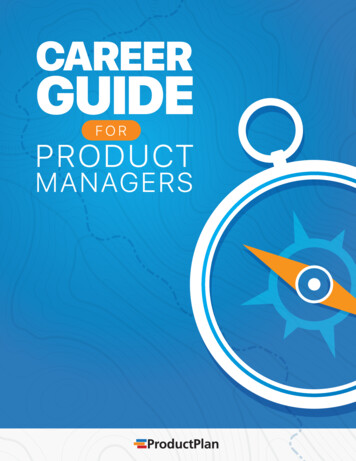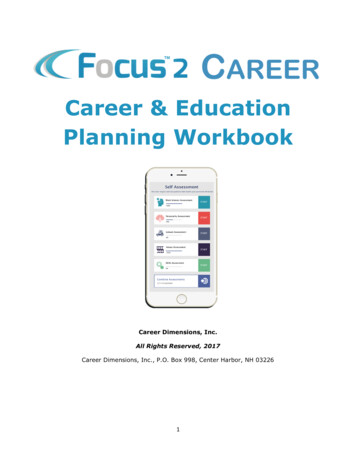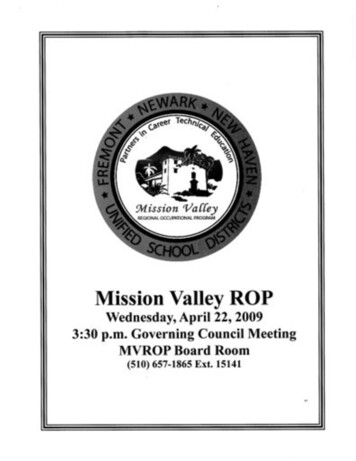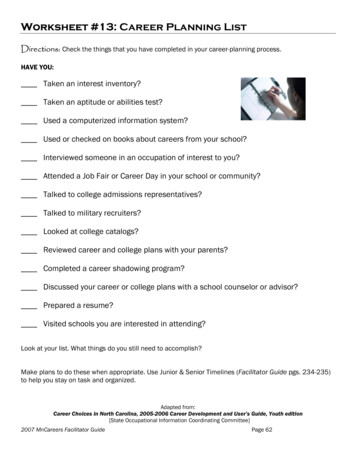
Transcription
CAREERGUIDEFORPR O D UCTMANAGERS
Table of contents:Why We Wrote This Book.3Chapter 1: Getting Started in Product Management.5The Product Management Career PathTips for Hiring a Great Product ManagerQuestions Every Product Manager Candidate Should Ask During an InterviewKey Responsibilities of Product ManagersStrategies for Creating an All-Star Product TeamThings Every Product Manager Should Do in Their First 30 Days at a New CompanyChapter 2: Strategies for Working with Stakeholders and Team Members.33How Do I Build Shared Understanding?Conflict Management Recommendations for Product ManagersThe Empathetic Product ManagerHow Product and UX Teams Collaborate to Build Great ProductsChapter 3: Strategies for Interfacing with Customers.56When Should Recurring Feature Requests Lead to Re-evaluating Your Product Strategy?Dealing With an Unreasonable CustomerHow Product Managers Can Say No (and Still Get Invited to Lunch)Chapter 4: Optimizing and Supporting Your Product.78Becoming a Better Product Advocate Within Your CompanyAre you a Thought Leader or a Follower?Lies Product Managers Tell ThemselvesCan You Ever Stop Improving Your Product?Chapter 5: Making the Most of Your Time.99Product Managers: Don’t Waste Your Time On These Six ThingsTips for Remote Product TeamsChapter 6: Helpful Resources for Product Managers. 111Great Podcasts for Product ManagersMust-Read Books for Product ManagersWhat Should Your Product Stack Include?Product Management Conferences You Should AttendProduct Management Training: Five Excellent ResourcesCAREER GUIDE FOR PRODUCT MANAGERS:2
Why we wrote this bookAt ProductPlan, we’ve had the opportunity to work with innovative productmanagers from some of the world’s most interesting and successful companies.Some of these product managers are veteran product owners with decadesof industry experience. Others are brand new to the field. All of these productmanagers have had something important to teach us about navigating a career inproduct management. We’ve been fortunate to learn from these experts throughwebinars, guest blog posts, and interviews, and we’re excited to pass thoselearnings on to you, wherever you might be in your own career.In this book, we set out to produce a reference guide for product managers atall levels. The book begins with Chapter 1, a look at the hiring process from theperspective of both the candidate and the hiring manager. It covers interviewingand hiring tips, including questions to ask when you interview, what to look for in astellar product manager, and also gives some context on the field as a whole, howpeople end up in product, which types of personalities you might find in productmanagers, and how you might put together the perfect product team.Chapters 2 and 3 present concrete strategies for effectively communicatingwith colleagues and customers. Chapter 2 focuses on interfacing with productstakeholders, giving product managers tactical advice for building sharedunderstanding in their organization, resolving conflicts and disagreements aboutpriorities, resources, and more, and outlines the importance of empathy. Similarly,Chapter 3 offers guidance on communicating with customers, covering everythingfrom effectively managing customer feature requests to developing graceful waysof saying “no” to your customers.Chapter 4 focuses on strategies for optimizing and supporting your product andyour role as product manager, discussing ways to become a thought leader andCAREER GUIDE FOR PRODUCT MANAGERS:3
advocate for your product within and outside of your organization. Chapter 4 alsoasks whether it’s possible to ever stop improving your product, whether the work ofthe product manager is ever done, and humorously (but pointedly) highlights some“lies” or myths product managers should avoid telling themselves.Chapter 5 offers suggestions for making the most of your time, whether yourproduct team is remote or on-site, small or large, located within the same timezone or spread across the world. Like the “lies product managers tell themselves”in Chapter 4, this chapter offers advice to avoid common time-traps, areas whereproduct managers are likely to fall into distraction and decreased productivity. It’san important chapter for all product managers, whether they’re brand new to thefield or seasoned product experts; there’s always room for optimization.The final chapter includes several different collections of resources for productmanagers hoping to augment their product knowledge. Product managers are oftenlifelong learners with insatiable curiosity and Chapter 6 aims to point them in thedirection of some great learning resources: Product-oriented podcasts, books,software, conferences, and training resources.With this book, we hope to pass on some of the great tips we’ve received fromproduct managers over the years we’ve been developing our roadmappingsoftware. We’ve had the opportunity to chat with hundreds of product managersabout their roles and their personal professional experiences. The goal of thisbook is to condense all of those conversations and tips into a single career guidefor product managers. We’ll keep updating it, so please send us any other careeradvice you’ve picked up along the way.We hope you enjoy it.Jim SemickProductPlan Co-Founder and Chief StrategistCAREER GUIDE FOR PRODUCT MANAGERS:4
CHAPTER :1GETTING STARTEDIN PRODUCT MANAGEMENTThis chapter introduces the product management profession, both from theperspective of prospective product managers and veteran product leaders. Itcovers interviewing and hiring tips, including questions to ask during your interviewand what to look for in a product candidate. It also offers a general map of theproduct manager career path from associate product manager all the way up toChief Product Officer and beyond.
CHAPTER :1The Product ManagementCareer PathWhat is the product manager career path?The product manager career path is a fascinating one with lots of potential onand off-ramps. At ProductPlan, we’ve spoken to many product leaders abouttheir career trajectories and past professional experience, and have found thereis significant variation in titles, responsibilities, and hiring and promotion criteria.Some product organizations have associate and senior product managers, whileothers have only a single role with varying levels of responsibility. Factors likecompany size, budget, business goals, and more will have an impact on how theproduct team is structured. Despite the different company-specific permutations,it’s valuable to establish a general product manager career path.CAREER GUIDE FOR PRODUCT MANAGERS:6
Associate Product ManagerFor this entry-level product role, hiring managers are looking for you todemonstrate both that you have an understanding of what product managementis and that you have a clear interest in and passion for the customer. Your firstproduct management job is not like school. It’s not about knowing the most,working the hardest, or beating the competition. It’s more of an art. It’s aboutdemonstrating your empathy for the user, highlighting your ability to identify issuesand opportunities, and collaborating with others. It’s important to show you canhear all sides of a story, synthesize and assess the different perspectives, andarrive at a clear decision.Since much of product management involves formulating and asking the right kindsof questions, you’ll also be expected to demonstrate your curiosity. Annie Dunham,ProductPlan’s Director of Product, says she always asks candidates to tell her aboutsomething they’ve recently learned. This kind of question can reveal a lot about aperson’s natural curiosity and passion for learning. You can also demonstrate thesequalities by thinking carefully about the types of questions you should ask during aproduct interview.In terms of the day-to-day work, associate product managers can expect to beinvolved with everything a product manager typically does, just on a smaller scale.In other words, you may not set the product strategy or own the product roadmap,but you will set priorities for your own projects. You may not be presenting productplans across the company, but you’ll be responsible for keeping your peers andyour manager updated.Associate product managers will be responsible for prioritizing tasks with a definedset of constraints, not necessarily defining which tasks they’re performing, butmaking scoping and prioritization decisions around the tasks or projects they’reassigned. Associate product managers will work and collaborate daily with othermembers of the product team, as well as other adjacent teams like UX andCAREER GUIDE FOR PRODUCT MANAGERS:7
engineering. During this work, they’ll regularly communicate the status of theirproduct to all relevant stakeholders. Your job is to balance business objectivesand customer needs, reconciling the goals of the business with benefits to thecustomer. You’ll need to ask yourself if a feature is needed, and if so, why? How is itsolving a customer problem and moving the needle for the business? This last pointintroduces the importance of measurement. As an associate product manager,you’ll need to continually speak to the “this is what we’re doing and why we’redoing it” question, and you’ll rely on metrics to let you know if you’re successful.So, when are you ready to move from an associate role into a full product managerrole? You’ll be completely on top of the above activities. You’ll have establishedyourself as the “go to” person for your product set and will have developed anexcellent working relationship with engineering, UX, marketing, and other teams.You should be comfortable delegating some of your tasks to someone else andtrusting in the process you’ve helped establish, and you should be prepared tospeak to what is needed in the associate role in order to mentor your replacement.Product ManagerTo land a full-fledged product manager role, you’ll likely need to come in with someexperience. You don’t necessarily need direct product management experience,but you’ll need to have had some professional experience that clearly demonstratesyour communication, collaboration, and prioritization skills. Though you might notneed hands-on product experience, you’ll definitely need to be able to speak tobasic product concepts and walk in with a hit-the-ground-running attitude.This mid-level product role is similar to the associate level product managerposition, except that in addition to being your product’s “go to” resource for otherteams, you’ll be the point person for the product team itself related to your product.You’ll be consulted for advice on process, relationships, tactical moves, etc., andwill need to be confident and well-informed by data.CAREER GUIDE FOR PRODUCT MANAGERS:8
In order to move into a senior product manager position, management will need tobe confident you’re doing your job well and are driven to help the team accomplishits broader goals. You should have a demonstrable understanding of the customerbenefit your product provides, be able to articulate the specific customer problemsit’s solving, and be able to tie product metrics to business goals in a compellingway. In other words, everything should be running and running smoothly; internaland external customers should feel informed and engineering, UX, and marketingshould trust and respect you. You’ll also know it’s time to move on because you’rehungry for more.Senior Product ManagerTypically, at this point on the product manager career path, you’ll need to have hadsome direct product management experience. At minimum, a successful seniorproduct manager will come in with professional experience that demonstrates herability to think on her feet, be accountable for decisions, lead by example, andmake data-driven decisions based on a multitude of complex, interdependentfactors. This role will also require deep product and market knowledge.In terms of day-to-day responsibilities, senior product managers perform most ofthe same duties as described under the associate and mid-level product managersections, just with higher-impact, higher-visibility products. They are in a positionto lead other, more junior product managers and work closely with product leadersin the organization to contribute to and execute on product strategy. While otherproduct managers might be heads down in the data or more involved with customerinterviews and feedback, senior product managers begin to look more at thebroader product process and start to become more of a voice for the product teamto leadership.Senior product managers that become a critical source of advice for other productmanagers and that successfully advocate for the product team to senior leadershipare well-positioned to move on to a director-level role. This is especially true forCAREER GUIDE FOR PRODUCT MANAGERS:9
senior product managers that are consistently exhibiting curiosity and passion notjust for their product and customers, but also for the product process itself.Director of ProductA director-level role in product will require leadership experience, and the ability tobuild and trust a team to do the work you previously did as a sole contributor. TheDirector of Product role will further focus on building better processes and honingexisting ones, improving overall team performance, and building consensus acrossthe entire organization.You’ll regularly meet with your peers throughout the company—this is what’shappening and why, what do you need from product, this is what product needsfrom you, etc. This role relies heavily on data. You have a team focused onindividual KPIs but you’re responsible for connecting those small-scale numbers tothe broader success metrics of the business as a whole.Directors of Product spend a significant amount of time researching the marketlandscape their product lives in. What’s the latest info on competition? Whatare new product best practices? How can we improve our product developmentprocess, relationship between teams, and executive buy-in?Product directors are also a resource and mentor for the rest of the productmanagement team. Product teams will have a variety of strengths and part of adirector’s job is to put those strengths to work for the benefit of the company whilehelping individual product managers improve in other areas. You’ll advocate forthe team and for your product strategy, and you’ll own and present the productroadmap to the rest of the organization, and make sure your team understandseverything happening at the higher levels of the business and the market. You’llparticipate in strategic projects as needed, but will spend the majority of your timecrafting high-level strategy and ensuring your team’s activities are advancing thatstrategy in the most effective way possible.CAREER GUIDE FOR PRODUCT MANAGERS: 10
VP of ProductAt this level, you are significantly less involved with the hands-on activities relatedto the product development process. In a large organization, there might be morethan one VP of Product, depending on the number of product lines. Whetherthere’s one VP or several, this role is a high-level support resource for the productorganization, responsible for the entire product set and how it fits into the rest ofthe organization.Activities and responsibilities include budgeting for the product organization,ensuring that strategic product decisions align with business objectives, andprotecting the product team from infighting and internal politics. The VP role is boththere to enable the product organization at the high level and to act as a checkon activities from the perspective of the business, C-level stakeholders, and, ifapplicable, the board of directors. VPs of Product might also participate in speakingengagements, and look at how the product contributes to thought leadership. A lotof a VP’s time is spent thinking about what needs to happen with the team today tobe ready for what’s coming a year from now, i.e. futureproofing your product andteam. In this role, your product team is tactical, while you are primarily strategic.Chief Product Officer and beyondIf your organization has a CPO, that might be the next logical step for anexperienced VP of Product. Chief Product Officer is either an expanded variationof the VP of Product role, or one that oversees multiple VPs of product rolling up toone product leader. At this level, you’re looking at a product portfolio, and makingsure staffing resources, budget, and research are being invested in the areas thatwill provide the combined best benefit. You’re tracking numbers 3-6 months out,but you’re making strategic decisions for the 3-5 year timeframe. You’re settingthe aspirational product goals to inspire and push your team, i.e. “Here’s what wecan be, here’s what we will be, here’s what success looks like this quarter, year,and so on.”CAREER GUIDE FOR PRODUCT MANAGERS: 11
At this point on the product managercareer path, your product really becomesthe product organization itself.Apart from CPO, there are lots of other options for veteran product folks: GeneralManager, COO, CEO, and more. Product folks tend to make great GMs and COOsbecause they’re used to working across the entire company to move businessobjectives forward. The same methodologies they’ve been practicing their entirecareer—understanding an issue, strategizing, prioritizing work, testing, validating,etc.—come into play at this level as well, although they look a little different.You’ll make budgeting decisions not just across one department, but across theentire organization, relying as you always have on data and KPIs. At this level,you’ll be developing, measuring, and constantly improving on objective criteriafor success, and you’ll be responsible for mentoring and energizing people doingvastly different types of work across the entire organization. In other words, atthis point on the product manager career path, your product really becomes theproduct organization itself.CAREER GUIDE FOR PRODUCT MANAGERS: 12
Tips for Hiring a GreatProduct ManagerIn our many discussions with product leaders from around the world, we’ve gleanedsome insights regarding the traits they look for in prospective product managers.Whether you’re on the hiring side yourself or interviewing for a product role, wethought you would benefit from some advice on how to identify and hire a greatproduct manager.1. Problem-solving abilityMany of the product leaders we’ve worked withhave told us that problem-solving ability is the traitthey value most in a product manager.These CPOs and Directors of Product understandthat product management is a tricky role—onein which there are always a lot of moving parts—and that driving a product successfully to themarket will require plenty of creative solutions tounexpected challenges. So, when they’re lookingfor a new product manager, sharp product leaderslook for natural problem-solving aptitude, whichoften presents itself as creative thinking, flexibility,LOOK FOR:1. Problem-solving ability2. Great communication skills3. Empathy4. Leadership5. Insatiable curiosity6. Passion7. Comfortable with failureand ingenuity.2. Great communication skillsVirtually every product executive we’ve ever spoken to on the subject of hiring haslisted communication as one of the top skills they demand in a product manager.CAREER GUIDE FOR PRODUCT MANAGERS: 13
Even if a candidate checks all of the other boxes—solid product managementbackground, experience in your company’s industry, strong technical knowledge—that product manager is far less likely to prove effective if he or she can’tcommunicate clearly and effectively with various product stakeholders. Productmanagers regularly interface with engineers, executives, sales teams, marketingteams, as well as customers and prospective customers. They need to effectivelysolicit and communicate valuable product-related information on a daily basis.3. EmpathyAnother attribute that product leaders look for in product managers is empathy—in this context, the ability for a product manager to truly see things from hercustomer’s point of view. Product managers need to be able to put themselves intheir customers’ shoes and build products to solve their customers’ problems, meettheir needs, understand their jobs, motivations, and desires. The worst mistake aproduct manager can make is to ignore their customers, build their product in avacuum and release something no one wants to use or buy.4. LeadershipProduct managers have the difficult role of coordinating and leading a large, crossfunctional team, often without any formal authority over anyone on that team. Infact, some of the team’s members, such as the VP of Engineering, might be wellabove the product manager in the organization’s hierarchy.How, then, can a product manager successfully drive such a complex initiative,when they don’t have any organizational power over the people executing thedetails? With natural leadership skills.Many product leaders have told us that a great product manager will have theability to build chemistry and generate enthusiasm among the various teams anddepartments responsible for developing his or her product. This is no small task,considering that often the same product manager will have to say no to requestsfrom these teams, or push them to work more quickly or with fewer resources.CAREER GUIDE FOR PRODUCT MANAGERS: 14
You want a product managerwho will be internally motivatedto keep asking and lookingfor novel solutions.To succeed in the face of all of these inevitable challenges, a product managerwill need charisma—to make that cross-functional team feel as invested in theproduct’s success as the product manager, and to want to actively contribute tomaking that success happen.5. Insatiable curiosityAnother important trait is curiosity. Product management is a role that requires agreat deal of initiative and intrinsic motivation. It’s very difficult, after all, for a VP ofProduct to tell her product managers exactly what they should be doing on a dayto-day basis, and it can be very easy for a product manager to settle for the firstidea or first answer they come up with.This is why smart leaders look for curiosity: product managers don’t know whatthey don’t know and because often the best strategic decisions will emerge onlyafter serious research and investigation, you want a product manager who will beinternally motivated to keep asking and looking for novel solutions.6. PassionWhen evaluating a product manager candidate, many product leaders lookfor passion. Product development can be a long process—often months andsometimes even years—and that process is often punctuated along the way withsetbacks and disappointments.CAREER GUIDE FOR PRODUCT MANAGERS: 15
Don’t overlook natural passionas a key trait in the product managersyou bring onto your team.If the product manager responsible for driving that long, setback-riddendevelopment isn’t passionate about seeing her product through to a successfulmarket launch, then the whole effort can slide off the rails at any point.7. Comfortable with failureSmart, visionary product managers take the long view. They know that any singleproduct in a line, or any specific market launch, might fall flat for any numberof reasons.That’s why product executives have told us repeatedly they would like to knowthat any product manager they hire won’t fall to pieces at their first productdisappointment. Instead, they want a product manager who will be able to reactappropriately, take a moment to grieve, and then start gathering useful learningsthat can propel the next launch to success.CAREER GUIDE FOR PRODUCT MANAGERS: 16
Key Responsibilities ofOutstanding ProductManagersThe role each product manager plays depends on many dynamics—company size,industry, the type of product, the stage of the product, and company culture allinfluence the exact form the product manager role will take.Case in point: The three statements below come from three very different (and real)product management job descriptions: H as responsibilities to manage the product from concept to design,sample production, testing, forecast, cost, mass production, promotion,support, and finally product end of life. D elivers the operating plan: achievement of growth objectives includingmarket share, revenue, profit, and return on investment for all thechannels/categories of business and/or key customers. R esponsible for managing and implementing marketing activities throughresearch, strategic planning, and implementation.CAREER GUIDE FOR PRODUCT MANAGERS: 17
Quite different, aren’t they? Whether we look at 3 or 100 job descriptions, youcan see that each product management role is varied and unique. What thisunderscores is that many businesses have vastly different views about what aproduct manager does, and where her ultimate responsibility begins and ends.So, what are the key responsibilities of a product manager? And how can you usethe role most effectively to usher successful products into the world?The Key Role of Product Managers: A Working DefinitionIn most cases, your core role as a product manager will be two-fold: T o set the long-term vision and strategy for your company’s products. T o communicate this strategy to all of the relevant participants and stakeholders.Typically, the primary tool you will use to accomplish your key roles—productstrategist and communicator—will be a product roadmap, which is a strategic,high-level document that conveys the “why” behind the products you’re building.As a product manager, it is important to understand that you are a central hubwithin your company for a lot of critical information about your products, market,competitors, customers, prospects, key industry analysts, and many otherconstituencies.To succeed, you will need to continually gather and analyze data and businessintelligence from all of these sources (as well as internal sources like your salesCAREER GUIDE FOR PRODUCT MANAGERS: 18
and customer success teams)—and use this data to inform the evolution of yourproduct roadmaps.Given that you will need to interact with a broad range of stakeholders and teamsto ensure your product’s success, and that you will also need to translate the inputand data you gather to build a case for many decisions you present in your roadmap,there are four critical skills you’ll want to bring to your role as a product manager:1. Be transparent about your prioritization and roadmap process.Remember, much of your role as a product manager will be explaining “why” tovarious stakeholders and constituents—why you are prioritizing one feature ortheme over another in a release; why you’ve chosento focus more on one particular goal for the nexttwo quarters versus another goal, etc.The best way to get the relevant constituencies—sales, marketing, engineering, your executives—onboard with your strategic thinking is to be clear andopen with them about why and how you are making4 SKILLS C RITICAL1. Be transparent2. Be able to say “No”decisions.3. Be a ruthless prioritizer2. Be able to say “No,” but explain why in terms4. Evidence-baseddecision-makingthat stakeholders understand.There will be plenty of times when an executivewill ask for a new feature his gut tells him will be great, or when an engineer willsuggest tabling the development of a feature set to save time on the next sprint, orwhen a sales rep will ask (even beg) you to add a specific tool to the next releasebecause a prospect has promised to buy if it’s included.But if those requests will undermine your strategic objectives for the product,you will often have to say no. The key will be in your ability to articulate why (thatall-important word in a successful product manager’s vocabulary) you cannotCAREER GUIDE FOR PRODUCT MANAGERS: 19
accommodate the request. Again, the more strategic and backed by evidence youcan make your roadmap, the more likely your constituents are to understand whenyou need to say no.3. Be a ruthless prioritizer while balancing the needs of customersand stakeholders.Regardless of your company’s size or budget, you will always face limited resourcesfor your product development. That means you will always need to prioritize, andcontinually weigh the competing factors of your objectives for your products, yourcompany’s limited resources, and demands from various stakeholders.If you’re not sure how to set priorities or how to weigh various factors in developingyour roadmap, there are several great models that can help you get started—suchas weighted scoring.For a detailed explanation of these and other proven models you can use toprioritize your roadmap items check out our other book, Product Roadmaps: YourGuide to Planning and Selling Your Strategy.4. Bring evidence-based decision-making to your communication.As I’ve stated previously, one key trait of successful product managers is theirability to answer “why” to the many questions they must field from stakeholdersthroughout their organizations. One of the most effective ways to answer why iswith evidence. It’s much more compelling than your opinion—or anyone else’s.If you have real-world user data, customer feedback, and metrics on your productthen you already have an excellent source of business intelligence to inform howbest to build your product roadmap. Let your own analytics help guide and informyour decisions.If you don’t have real-world user data on your products yet, don’t worr
IN PRODUCT MANAGEMENT This chapter introduces the product management profession, both from the perspective of prospective product managers and veteran product leaders. It covers interviewing and hiring tips, including questions to ask during your interview and what to look for in










